The Central Bearded Dragon (Pogona vitticeps) is a popular choice among reptile enthusiasts due to its captivating appearance, docile nature, and relatively easy care requirements. Originating from the arid regions of central Australia, these fascinating creatures have become beloved pets worldwide.
In this article, we will explore the key aspects of the Central Bearded Dragon, shedding light on their natural habitat, physical characteristics, lifespan, temperament, and so on. We will also explore important considerations for creating an optimal habitat, providing a nutritious diet, maintaining proper lighting and temperature, and ensuring the overall well-being of your scaly companion.
 Species Profile
Species Profile
| Family: | Agamidae |
| Class: | Reptilia |
| Genus | Pogona |
| Species | Pogona vitticeps |
| Lifespan | 8-12 years, sometimes more with proper care |
| Length | 18-24 inches, with males being slightly larger than females |
| Weight | 0.5-1 pound |
| Conservation Status | Least Concern |
| Energy Level: | Moderate |
| Personality | Docile, curious, sociable, alert, and inquisitive |
| Temperament | Generally calm and friendly |
| Intelligence | Relatively intelligent and capable of learning |
History of The Central Bearded Dragon
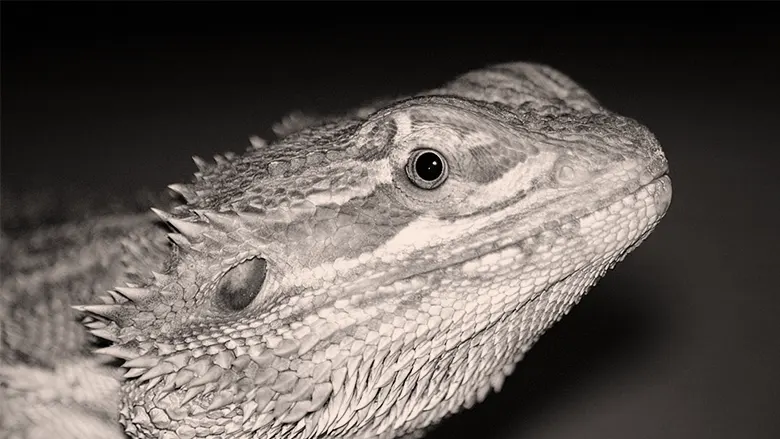
The Central Bearded Dragon, or Pogona vitticeps as it’s scientifically known, hails from the wide-ranging arid to semi-arid regions of Eastern and Central Australia. Although they have adapted incredibly well to a variety of habitats, their origins can be traced back to the deserts, arid and subtropical woodlands, scrublands, savannahs, and even shore areas of Australia.
Their low, wide body shape and rubbery, spiky scales are ingenious adaptations to this harsh environment, allowing them to regulate their body temperature and intimidate potential predators.
The Leap to Foreign Lands
Surprisingly, the global popularity of bearded dragons as pets can be attributed to legislation. In the 1960s, Australia banned the export of wild bearded dragons. Razor-sharp entrepreneurs, however, saw an opportunity. While wild bearded dragons could no longer be exported, bred specimens were fair game.
This led to the foreign propagation and global popularity of bearded dragons, particularly in the United States. Soon, they found their way into homes across continents, with breeders experimenting selectively to produce a stunning variety of color “morphs“.
From the Outback to Our Hearts
Today, Central Bearded Dragons are among the most popular reptile pets, thanks to their charismatic display of behaviors, relatively low maintenance, and formidable, yet loveable appearance.
Their journey serves as a potent reminder of how even the most unlikely of creatures can bridge the divide between the wilderness and domestic life, thriving in environments far removed from their natural habitats.
Characteristics and Appearance

Central Bearded Dragons are a popular reptile species known for their distinctive appearance and captivating personalities. Here are some key characteristics and details about their appearance:
- Size: Adult Central Bearded Dragons typically reach a length of 18 to 24 inches (45 to 60 cm) from snout to tail, with males often growing slightly larger than females. However, there can be variations in size depending on factors such as genetics and care.
- Head and Body: Bearded Dragons have triangular-shaped heads with a rounded snout and large, round eyes on either side. They possess rows of small, spiky scales along the sides of their heads and larger spines under their jaws, which can puff up into a “beard” when they feel threatened or display dominance. The body is stout and covered in small, pointed scales.
- Coloration: Central Bearded Dragons display a wide range of colors and patterns. They often have a base color of tan, brown, or gray, which can be accompanied by various shades of red, orange, yellow, or even blue. The patterns may include stripes, bands, bars, or spots, providing camouflage in their natural habitat.
- Tail: The tail of a Bearded Dragon makes up a significant portion of its overall length. It tapers towards the tip and is often banded with different shades of color. The tail serves multiple purposes, including fat storage and balance during climbing and movement.
- Limbs: Bearded Dragons have four well-developed limbs with sharp, curved claws. Their limbs allow them to climb, perch, and dig. The front limbs have five digits, while the hind limbs have four digits with an additional enlarged claw, known as a “spur,” on the inner side of each hind leg.
- Sexual Dimorphism: Male and female Central Bearded Dragons exhibit sexual dimorphism, with some notable differences in appearance. Mature males tend to have larger heads, more prominent femoral pores (small pores on the underside of the hind legs), and a broader tail base compared to females. Females may have smaller heads, smaller femoral pores, and a slimmer tail base.
- Bearded Display: One of the most iconic behaviors of Bearded Dragons is their ability to puff out their throat and chin, creating a “beard” of spiky scales. They typically display their beard when threatened, to establish dominance, or during courtship rituals.
Behavior and Temperament
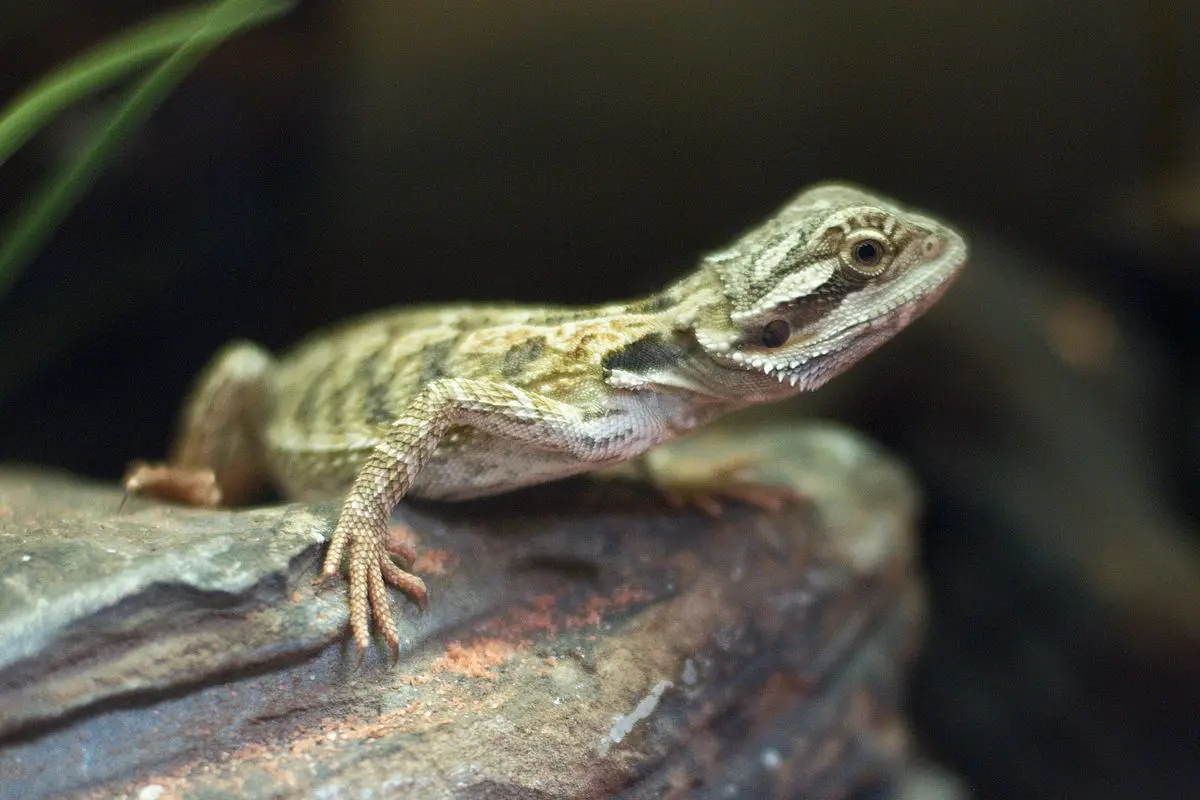
Despite their name, bearded dragons are nothing like their mythical distant cousins — they are not fierce or menacing, and they don’t spit fire either. In fact, they’re more like that introverted-extrovert friend we all have – the one who enjoys their own company but doesn’t shy away from social interactions either. Let us explore their various behaviors:
The Socially Adept Loner
Bearded dragons enjoy a good balance of solitary time and interaction. They aren’t particularly social with their species and prefer to bask alone instead of having a pool party under their heat lamp.
But flip the coin, and they show a surprising interest in humans. They can recognize their caregivers, often seem amenable to handling, and some even appear to enjoy a snuggle session or watching TV with you. Feel special yet?
Docile Nature
Bearded dragons, in general, have a reputation for being calm and placid pets. Their demeanor leans more towards the ‘chillaxed couch potato‘ end of the spectrum rather than the ‘run around like a toddler on a sugar high‘. They aren’t aggressive and are often seen lazing around their enclosure, basking in the heat or surveying their terrain from their favorite spot.
The Active Admirer
Despite their tranquil demeanor, though, bearded dragons can be quite active during the day. They’ll roam around their enclosure, dig at the substrate, bob their head, or wave their arms in the cutest possible way.
They’re also avid climbers, so don’t be surprised if you spot yours attempting a mini version of rock climbing on the furniture you provide. An adventurous spirit lurks beneath that calm exterior!
Communication
Bearded Dragons have a range of communication methods. They use body language to convey their mood and intentions. For example, a flattened or puffed-up beard often indicates aggression or stress, while a relaxed posture with a slightly raised head signifies contentment. They may also use tail movements, arm-waving, and head bobbing as forms of communication.
Hibernation
Just when you thought you had your beardie figured out, they might throw you for a loop by going into brumation – a type of hibernation where they’ll become lethargic, eat less, and sleep more. It can be a bit worrying, but don’t panic! This is a natural, part of their behavior.
In their natural habitat, Central Bearded Dragons may experience periods of hibernation or brumation during cooler months. However, in captivity, it is not necessary or recommended to induce hibernation for most pet Bearded Dragons.
Intelligence and Curiosity
Bearded Dragons are relatively intelligent reptiles. They exhibit curiosity and may explore their environment, investigate new objects, and even recognize their owners over time. This intelligence makes them capable of learning basic commands and tricks with positive reinforcement training.
Housing Options
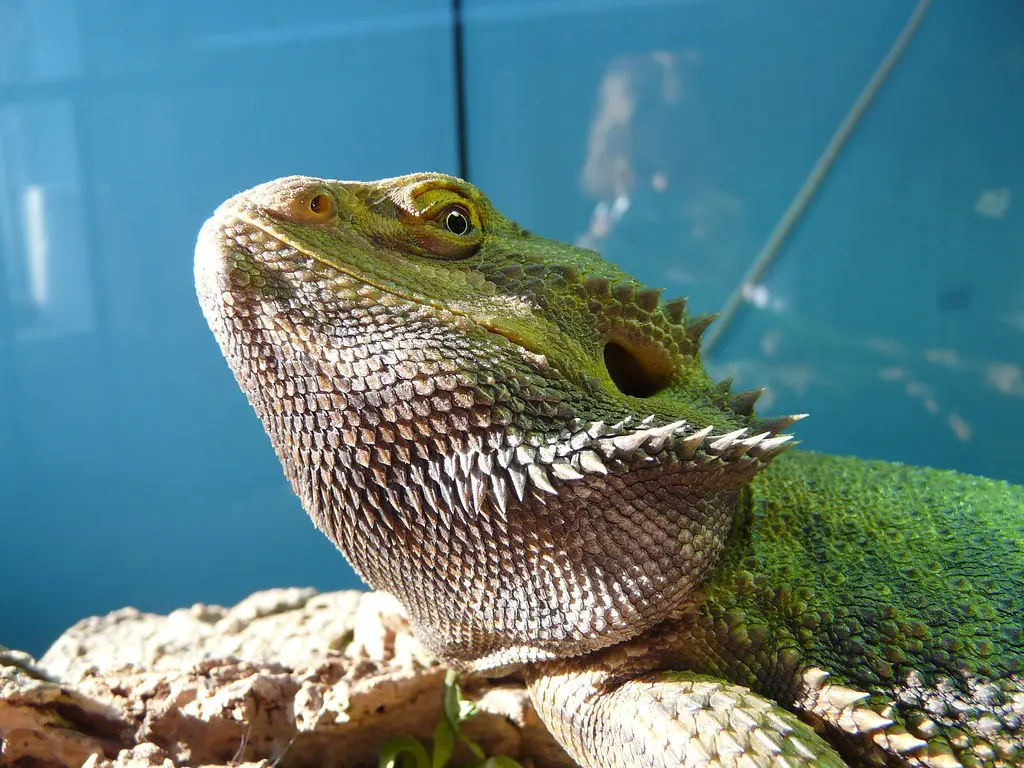
Picking the perfect home for your bearded dragon is essential. Juvenile dragons can be comfortably housed in a 20-gallon terrarium, while adult dragons require a minimum of a 40-gallon enclosure. A glass terrarium with a ventilated top is highly recommended to aid successful temperature regulation.
Make sure to include these essentials:
- Basking spot with heat lamp
- UVB light source
- Cool retreat for escaping heat
- Substrate (like reptile carpet, newspapers, or ceramic tiles)
- Climbing branches or logs
- Hiding spots for security
- Water dish
Glass vs. Wood: The “Great” Housing Debate
Glass terrariums are a popular choice, because, well, they look terrific! They allow for easy viewing and make the temperature regulation process a tad easier. But the flip side? Glass isn’t a great insulator, which could be tricky in colder environments. They’re also heavy and a sheer pain to move around.
Wooden vivariums, on the other hand, offer excellent insulation, making them ideal for keeping the heat just right. They add a rustic charm, but may obstruct your views of your pet. Your lizard might appreciate the privacy, but you’ll need to pop open the door more often for a quick ‘dragon check’.
Provide a heat source
Bearded dragons are straight from the ‘sunny and splendid’ heartland of Australia, and they heartily treasure their sunlight. In the confines of captivity, we mimic this warmth via specialized heat lamps.
The trick here is to set up a temperature gradient in their tank—one side toasty and warm (basking spot), the other a bit more on the ‘cool dude’ side—allowing them to regulate their body temperature by moving around.
UVB lights are important
Bearded dragons also require UVB light, vital for proper calcium absorption. This can be provided either through a UVB tube light that covers the majority length of the enclosure or a UVB mercury vapor bulb. The light-em-show should run about 12-14 hours a day, mirroring natural daylight hours.
Choosing a good substrate
Substrate is like the ground beneath our feet, a lizard equivalent of carpets and hardwood floors. Choices range from newspapers, reptile carpet, or ceramic tile to more natural options like play sand. The substrate should be safe, easily cleanable, and promote good hygiene. Here are some factors to consider when selecting a suitable substrate:
- Safety: The substrate should be non-toxic and free from any chemicals or substances that could harm your bearded dragon if ingested. Avoid substrates that may cause impaction, such as loose particles or materials that can be accidentally swallowed.
- Ingestibility: Bearded Dragons are known to explore their environment with their tongues and may accidentally ingest substrate while hunting or feeding. Choose a substrate that is not harmful if ingested and can pass through their digestive system without causing blockages. Avoid loose substrates like sand, walnut shells, or wood chips that can be easily consumed.
- Ease of Cleaning: Select a substrate that is easy to clean and maintain. Regular spot cleaning is necessary to remove waste and uneaten food. The substrate should be easily accessible for cleaning and should not retain moisture or odors.
- Hygiene: Go for a substrate that promotes good hygiene and reduces the risk of bacterial or fungal growth. Substrates that can be easily sanitized or replaced are ideal to maintain a clean and healthy habitat for your bearded dragon.
Here are some commonly used substrates for Central Bearded Dragons:
- Reptile Carpet: Reptile carpet is a popular choice as it is easy to clean, reusable, and provides a stable surface for your dragon to walk on. It prevents accidental ingestion and is relatively comfortable for your dragon.
- Ceramic Tile: Ceramic tile is another safe and easy-to-clean option. It provides a solid surface, allowing for easy movement and cleaning. Be sure to choose tiles without any sharp edges or rough surfaces that could cause injury.
- Paper Towels/Newspaper: For hatchlings or sick dragons, using paper towels or newspaper as a temporary substrate is a practical solution. They are easy to replace and maintain cleanliness, but they lack the aesthetic appeal of other substrates.
Soaking Areas
Providing a soaking area for your Central Bearded Dragon is an important aspect of their care routine. Soaking allows them to hydrate, aid in shedding, and engage in natural behaviors. Here are some guidelines for setting up a soaking area:
- Container Selection: Choose a shallow and sturdy container that is large enough for your bearded dragon to comfortably sit and soak in. A shallow dish or basin made of non-toxic material, such as ceramic or plastic, works well. Ensure the container is stable and cannot be easily tipped over.
- Water Depth: Fill the soaking container with warm water that is about ankle-deep for your bearded dragon. The water should be shallow enough that they can comfortably sit in it without the risk of submerging their head or causing stress.
- Water Temperature: The water temperature should be warm, but not hot, to provide a comfortable soaking experience. Aim for a temperature of around 85-90°F (29-32°C). Use a reliable thermometer to monitor and adjust the water temperature as needed.
- Supervision: Always supervise your bearded dragon while they are soaking to ensure their safety. Avoid leaving them unattended, as they may accidentally tip over the water container or struggle in the water.
- Frequency and Duration: Offer your bearded dragon the opportunity to soak in the water for approximately 15-20 minutes, a few times a week. Soaking frequency can vary depending on factors such as the dragon’s age, health, and climate conditions. Additionally, some dragons may enjoy soaking more frequently than others. Observe your dragon’s behavior and adjust the soaking frequency accordingly.
- Hydration and Shedding: Soaking provides an opportunity for your bearded dragon to hydrate by absorbing water through their vent area. This is especially important if they are not drinking sufficient water from their dish. Soaking also helps to soften and loosen the skin during shedding, making it easier for your dragon to shed without complications.
- Cleanliness: Keep the soaking container clean and free from debris. Clean and disinfect the container regularly to maintain good hygiene and prevent the growth of harmful bacteria or fungi. Replace the water with fresh, clean water for each soaking session.
Remember, not all bearded dragons enjoy soaking, and individual preferences may vary. If your dragon shows resistance to soaking, do not force them. However, providing the opportunity for regular soaks is generally beneficial for their overall health and well-being.
Care Tips
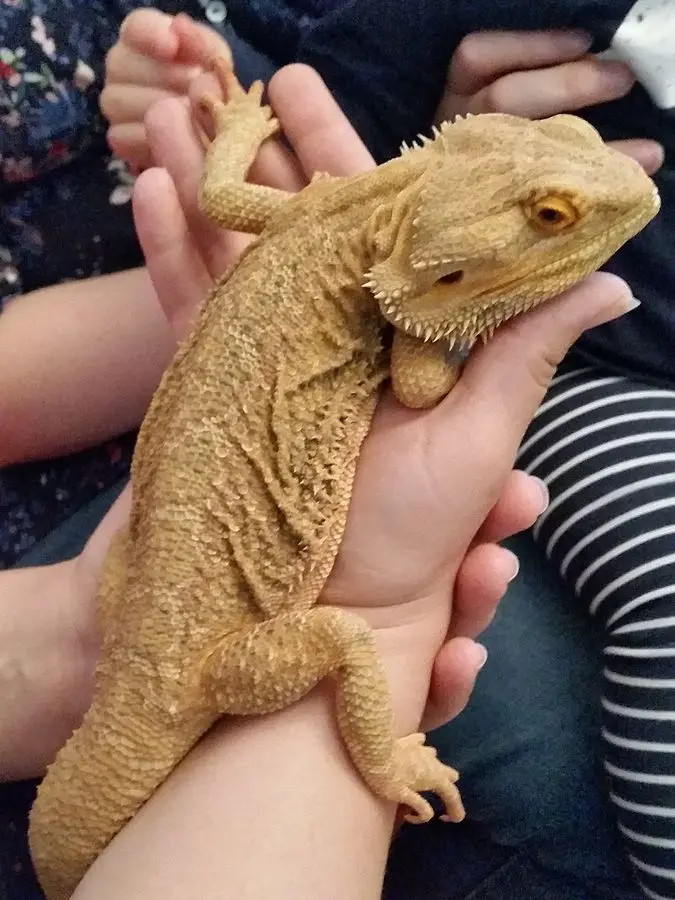
To keep your bearded buddy healthy and happy, follow these essential care tips:
- Temperature and Lighting: Maintain a temperature gradient in the enclosure. Provide a basking spot with a temperature of around 95-105°F (35-40°C) at one end, and a cooler area around 75-85°F (24-29°C) at the other end. Use a combination of heat lamps, ceramic heat emitters, and UVB lighting to create appropriate temperature and lighting conditions. UVB lighting is essential for calcium metabolism and overall health.
- Feeding: Offer a varied diet of appropriate-sized prey items. Central Bearded Dragons are omnivorous, and their diet should consist of live insects (such as crickets, dubia roaches, and mealworms) as well as a variety of leafy greens, vegetables, and fruits. Gut-load insects and provide calcium and vitamin supplements to ensure proper nutrition.
- Environmental Enrichment: Include a variety of climbing structures, branches, and rocks in the enclosure to create a stimulating environment for your bearded dragon. Provide hiding spots to allow them to retreat and feel secure.
- Handling and Socialization: Handle your bearded dragon regularly to promote socialization and establish trust. Be gentle and support their body properly while handling. Avoid excessive handling during times of stress, such as shedding or illness.
- Healthcare: Schedule regular check-ups with a reptile veterinarian to ensure your bearded dragon’s health. Monitor their appetite, bowel movements, and behavior for any signs of illness or distress. Maintain proper hygiene by regularly cleaning the enclosure and disinfecting as needed.
- Environmental Stimulation: Offer mental and physical stimulation through toys, puzzles, and supervised exploration outside of the enclosure. Bearded dragons can benefit from supervised time outside their enclosure for exercise and exposure to natural sunlight (if weather permits).
- Research and Learning: Stay informed about current best practices and advancements in bearded dragon care. Continually educate yourself on their specific needs, behavior, and potential health issues.
Grooming and Hygiene
Contrary to popular belief, bearded dragons do require some personal grooming and hygiene. Here are a few pointers that can help you provide the best grooming possible:
- Nail Trimming: Bearded dragons’ nails can become long and sharp, which may cause discomfort or injury to themselves or their owners during handling. Regular nail trims can help alleviate this issue. Use reptile-safe nail clippers or a nail file designed specifically for reptiles to carefully trim the tips of their nails.
- Oral Care: While bearded dragons do not require brushing like mammals, maintaining good oral hygiene is still important. Ensure that their diet consists of appropriate-sized prey items that help prevent dental issues. Also, monitor their mouth for any signs of infection, inflammation, or retained shed skin. Regular visits to a reptile veterinarian can help ensure proper oral health.
- Eye Care: Keep an eye on your bearded dragon’s eyes for signs of irritation, discharge, or swelling. If you notice any abnormalities, consult a reptile veterinarian for appropriate treatment. Also ensure that their enclosure provides appropriate humidity levels to prevent dryness or eye-related issues.
- Parasite Prevention: Parasites such as mites or ticks can affect bearded dragons. Regularly inspect your dragon for any signs of parasites, such as small moving specks or visible ticks. If you suspect a parasite infestation, consult a reptile veterinarian for diagnosis and appropriate treatment options.
My Dragon is Shedding: What To Do?
Remember that awkward phase during puberty, as you switched from cozy kiddie clothes to edgy teen wear? Your parents might’ve stood by the dressing room awkwardly, offering encouragement and occasionally trying to squeeze you into something you’d grown out of. Similarly, bearded dragons experience this growth and change, with the most notable difference being that their dressing room drama involves their own skin — a process known as shedding. And trust me, it’s not a sci-fi horror show; it’s something entirely natural and, dare I say, intriguing!
What to Expect
Bearded dragons, much like snakes and most reptiles, continually grow throughout their lives. As they mature from a wee dragonling to a majestic elder dragon, their skin doesn’t grow with them, leading to a periodic ‘skin update’. Think of it as going from one iPhone model to the next, only, the iPhone is furry and the model update is, well, scaly. The old skin loosens up, and bright, shiny new skin appears underneath.
It’s quite a spectacle to watch, though your beardie might be a tad grumpy, as shedding can be itchy and uncomfortable. This skin-changing show can occur quite frequently in younger dragons, slowing down as they age, much like us swapping out our wardrobe: seasonal change clothes frenzy as kids, versus the mature ‘maybe I’ll get ONE new shirt’ adult mindset.
How to Support Your Dragon’s Shed
Like a supportive parent outside the dressing room, there are ways you can lend a hand to your bearded buddy during the shedding process.
- Boost the Baths: Baths are a bearded dragon’s spa retreat. Just like a hot shower can loosen up your tense muscles, a warm bath can help the shedding process by alleviating discomfort and helping the skin peel off easier. Remember only to use shallow, warm water. You’re not training them for synchronized swimming.
- Humid Hide: A humid hide is a small shelter with enhanced humidity, which helps with the shed. You can make one by placing damp moss or a damp paper towel in a covered, accessible area inside their habitat. It’s like a DIY sauna on a budget.
- Hands off the Shed: It might be tempting to just peel off the loose skin. Resist! Pulling off skin before it’s ready can lead to injuries. TLDR: Do Not Disturb.
- Monitor Eating Habits: Shedding can sometimes dull a dragon’s appetite. If you see them starting to ignore their supper, think more ‘shedding blues’ than ‘food strike’. Keep a watchful eye on their eating habits, and if it persists, it’s vet o’clock!
Remember, all bearded dragon parents will have to contend with their pet’s shedding phase. In the grand scale of things, it’s a small price to pay for welcoming a magnificent, ancient lineage into your home.
Health Issues and Problems
Central Bearded Dragons can experience various health issues, mainly if proper care is not provided. Common health problems include:
- Metabolic Bone Disease (MBD): A calcium/vitamin D imbalance that can cause severe deformities and health problems.
- Respiratory infections: Caused by poor ventilation or incorrect humidity levels.
- Impaction: A severe, potentially fatal condition caused by the ingestion of indigestible materials or overly large food items.
- Parasitic infections: These can occur internally or externally (mites), usually as a result of poor hygiene practices.
Diet and Nutrition
A balanced diet is key to a healthy bearded dragon. The three main food types your beardy companion needs are:
- Insects: Offer live insects like crickets, dubia roaches, and mealworms, making sure they’re appropriately sized (no larger than the space between your dragon’s eyes).
- Vegetables: Provide a mix of leafy greens, veggies, and occasional fruit, aiming for 75% veggies/25% fruit.
- Calcium/Vitamin supplementation: Lightly dust insects with calcium powder and vitamin supplements before feeding to ensure your beardy buddy gets all the nutrients they need.
Mating in Central Bearded Dragons
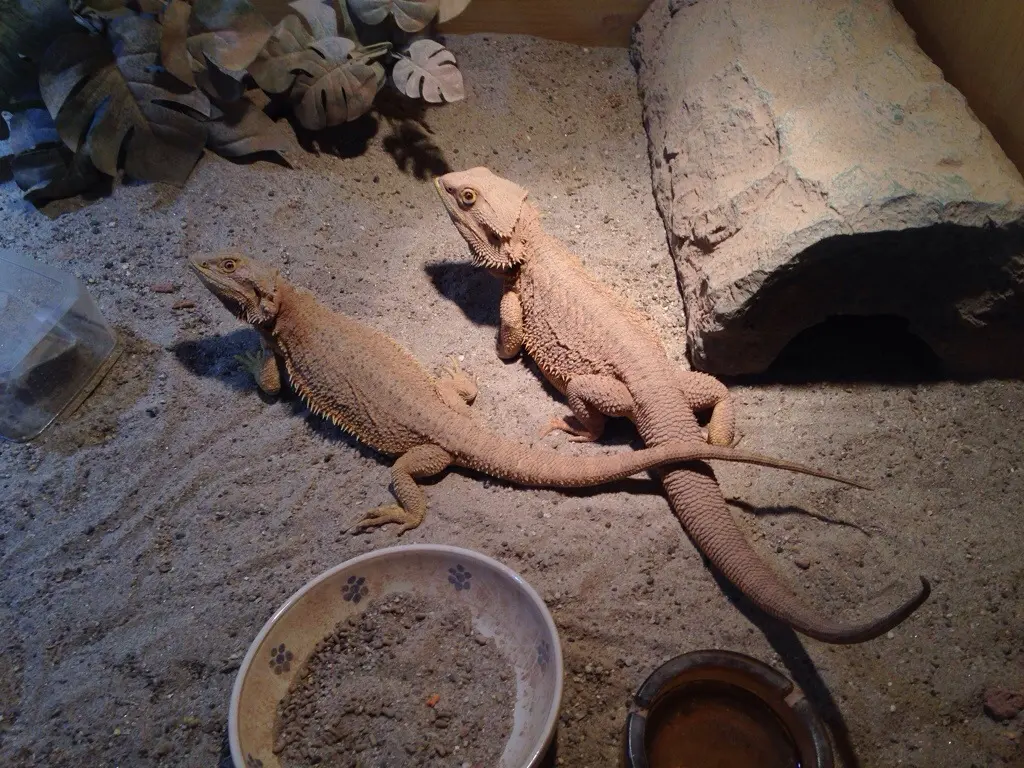
Mating in Central Bearded Dragons involves a series of distinct behaviors and displays such as:
Courtship Rituals: Male bearded dragons engage in courtship rituals to attract females. These rituals often involve head bobbing, arm-waving, and inflating their beard to display dominance and establish their breeding intentions. The male may also approach the female with a slow and deliberate gait while bobbing his head.
Male Aggression: During the breeding season, male bearded dragons may become more territorial and aggressive towards other males. They may engage in combat or territorial displays to establish dominance and secure mating opportunities.
Female Receptiveness: When a female bearded dragon is receptive to mating, she may display submissive behaviors such as head bobbing, arm-waving, and a flattened posture. The female may also raise her tail to allow the male to mount her.
Copulation: Once the male successfully mounts the female, copulation occurs. The male uses his cloacal region to transfer sperm to the female’s cloaca. Copulation can last for several minutes, with the male gripping the female’s neck or body during the process.
It’s important to note that not all bearded dragons will exhibit mating behaviors, and not all pairings will result in successful breeding. Introducing a male and female bearded dragon for mating purposes should be done with caution and under experienced supervision to ensure the safety and well-being of both dragons.
Conclusion
Central Bearded Dragons are captivating reptiles, exhibiting unique behaviors and characteristics that make them ideal for beginner enthusiasts and seasoned herpetologists alike. With proper care, a balanced diet, and the right housing environment, your bearded companion will be a fixture in your life for many years to come.
